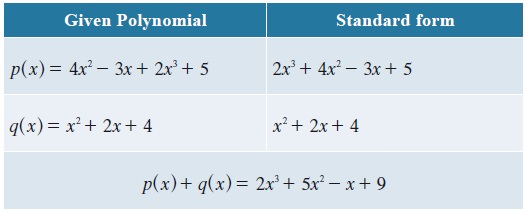Solved Example Problems | Mathematics - Arithmetic of Polynomials | 9th EM Mathematics : Algebra
Chapter: 9th EM Mathematics : Algebra
Arithmetic of Polynomials
Arithmetic of Polynomials
We now have a rich language of polynomials, and we
have seen that they can be classified in many ways as well. Now, what can we do
with polynomials? Consider a polynomial on x.
We can evaluate the polynomial at a particular
value of x. We can ask how the
function given by the polynomial changes as x
varies. Write the polynomial equation p(x)
= 0 and solve for x. All this is
interesting, and we will be doing plenty of all this as we go along. But there is something else we can do with polynomials,
and that is to treat them like numbers! We already have a clue to
this at the beginning of the chapter when we saw that every positive integer could be represented as a polynomial.
Following arithmetic, we can try to add
polynomials, subtract one from another, multiply polynomials, divide one by
another. As it turns out, the analogy between numbers and polynomials runs
deep, with many interesting properties relating them. For now, it is fun to
simply try and define these operations on polynomials and work with them.
1. Addition of Polynomials
The addition of two polynomials is also a
polynomial.

Example 3.4
Let p(x) = 4x2 - 3x+2x3+5 and q(x)=x2+2x+4 find p(x)+q(x)
Solution

We see that p(x)
+ q(x) is also a polynomial. Hence
the sum of any two polynomialsis also a polynomial.

2. Subtraction of Polynomials
The subtraction of two polynomials is also a
polynomial.

Example 3.5
Let p(x)
= 4x2-3x+2x3+5 and q(x)=x2+2x+4
find p(x)-q(x)
Solution

We see that p(x)
– q(x) is also a polynomial. Hence
the subtraction of any two polynomials is also a polynomial.
3. Multiplication of Two Polynomials
Divide a rectangle with 8 units of length and 7
units of breadth into 4 rectangles as shown below, and observe that the area is
same, this motivates us to study the multiplication of polynomials.

For example, considering length as (x+1) and breadth as (3x+2) the area of the rectangle can be
found by the following way.

Example 3.6
Find the product (4x
– 5) and (2x2 + 3x – 6).
Solution
To multiply (4x
– 5) and (2x2 + 3x – 6) distribute each term of the first
polynomial to every term of the second polynomial. In this case, we need to
distribute the terms 4x and –5. Then
gather the like terms and combine them:

Related Topics